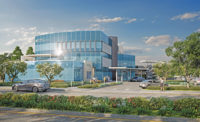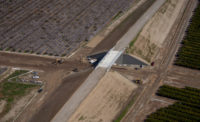Proposition 6 in California poses as a grassroots movement to repeal recently hiked and already high gas taxes when it is something else, too: a vote against the future. It would roll back the gas tax and vehicle fees passed by state lawmakers that kicked in last November. California Senate Bill 1, as the tax measure was called, has proven adept at generating billions of dollars to improve the state's transportation infrastructure, creating a $5-billion-a-year funding stream for bridges, roadwork and transit. The proposition also would limit the use of remaining gas taxes to road work so that none of the funds ever go toward the state’s high-speed rail project, possibly helping to kill it. The high-speed rail project has so far been paid for mostly via a mix of state bonds and federal funds.
Behind the proposition is the idea that most gas-tax money is siphoned off to high-paid government employees and that Californians in their cars are better off than Californians with a regionally planned mass transportation infrastructure, and drivers shouldn’t have to pay for one. The proposition’s advocates claim the state’s department of transportation has 3,700 employees not assigned to specific projects. That in their opinion suggests that Caltrans is a bloated and ineffective bureaucracy.
California Senate Bill 1 has proven adept at generating billions of dollars to improve the state's transportation infrastructure.
Last November’s new fuel taxes and vehicle registration fees do add significantly to the cost of driving. The San Diego Union-Tribune wrote that a car owner who puts 12,000 miles on a car that gets 25 miles per gallon would pay about $280 a year in state gas taxes and fees—close to the highest of any state. Proposition supporters put the cost to an average family with two vehicles at nearly $800 a year. The advocates properly note that higher fuel and vehicle costs boost the cost of most goods.
The ultimate outcome of a 'gas taxes for roads only approach' may be to kill the state's high-speed rail project and the improved transit hubs that will be created around the system's stations.
The economic and logistical benefits of high-speed rail are clear. With the fastest Amtrak train ride now available between Los Angeles and San Francisco a little over nine hours, is it any wonder people often choose to brave the horrendous highway traffic and drive? But high-speed rail isn’t only about carrying riders from Wilshire Boulevard to Nob Hill more quickly. It is about redirecting the ebb and flow of development and revitalizing urban centers. It is about fighting global warming. It is about uniting the already heavily used transit centers into a coherent system, facilitating commerce and family life. “If implemented well,” writes Egon Terplan, regional planning director for the San Francisco Bay Area Planning and Urban Research Association, “it can help leverage the billions in public investment that have already been committed” to these goals.
Money has poured into media campaigns both for and against the proposition. The controversy is being exploited as a way to bring small-government conservatives out to support specific candidates. They will note that the high-speed rail project so far has been far from perfect, with unexpected cost overruns. Any project of this complexity is bound to have ups and downs. What’s more important is that the proposition chains California’s future to sprawl and auto-centric transport. Californians on Nov. 6 must ask themselves if they are willing to imagine, and pay for, something better.
This commentary and its headline were corrected October 13 to reflect the fact that Proposition 6 and its restrictions on the use of gas taxes does not immediately deplete funding for the state's high-speed rail project, which is paid for via a mix of state bonds and federal funds.




Post a comment to this article
Report Abusive Comment